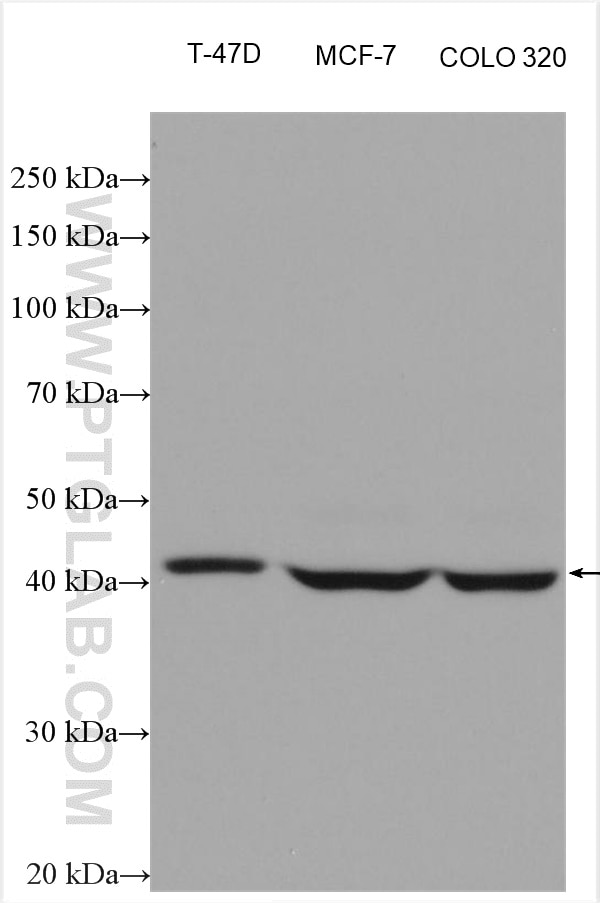Tested Applications
| Positive WB detected in | T-47D cells, HepG2 cells, MCF-7 cells, COLO 320 cells |
Recommended dilution
| Application | Dilution |
|---|---|
| Western Blot (WB) | WB : 1:2000-1:10000 |
| It is recommended that this reagent should be titrated in each testing system to obtain optimal results. | |
| Sample-dependent, Check data in validation data gallery. | |
Published Applications
| WB | See 2 publications below |
| IHC | See 1 publications below |
| IF | See 1 publications below |
Product Information
60134-1-Ig targets NR1H3 in WB, IHC, IF, ELISA applications and shows reactivity with human, rat, pig samples.
| Tested Reactivity | human, rat, pig |
| Cited Reactivity | human, mouse |
| Host / Isotype | Mouse / IgG1 |
| Class | Monoclonal |
| Type | Antibody |
| Immunogen |
CatNo: Ag6184 Product name: Recombinant human NR1H3 protein Source: e coli.-derived, PET28a Tag: 6*His Domain: 104-402 aa of BC041172 Sequence: KCQECRLRKCRQAGMREECVLSEEQIRLKKLKRQEEEQAHATSLPPRASSPPQILPQLSPEQLGMIEKLVAAQQQCNRRSFSDRLRVTPWPMAPDPHSREARQQRFAHFTELAIVSVQEIVDFAKQLPGFLQLSREDQIALLKTSAIEVMLLETSRRYNPGSESITFLKDFSYNREDFAKAGLQVEFINPIFEFSRAMNELQLNDAEFALLIAISIFSADRPNVQDQLQVERLQHTYVEALHAYVSIHHPHDRLMFPRMLMKLVSLRTLSSVHSEQVFALRLQDKKLPPLLSEIWDVHE Predict reactive species |
| Full Name | nuclear receptor subfamily 1, group H, member 3 |
| Calculated Molecular Weight | 50 kDa |
| Observed Molecular Weight | 44 kDa |
| GenBank Accession Number | BC041172 |
| Gene Symbol | NR1H3 |
| Gene ID (NCBI) | 10062 |
| RRID | AB_2154887 |
| Conjugate | Unconjugated |
| Form | Liquid |
| Purification Method | Protein G purification |
| UNIPROT ID | Q13133 |
| Storage Buffer | PBS with 0.02% sodium azide and 50% glycerol, pH 7.3. |
| Storage Conditions | Store at -20°C. Stable for one year after shipment. Aliquoting is unnecessary for -20oC storage. 20ul sizes contain 0.1% BSA. |
Background Information
NR1H3, also known as LXRA, is a liver X receptors, which form a subfamily of the nuclear receptor superfamily and are key regulators of macrophage function, controlling transcriptional programs involved in lipid homeostasis and inflammation. It's also a ligand-activated LXRs and forms heterodimers with retinoid X receptor, then participates in regulating expression of target genes containing LXR response elements.
Protocols
| Product Specific Protocols | |
|---|---|
| WB protocol for NR1H3 antibody 60134-1-Ig | Download protocol |
| Standard Protocols | |
|---|---|
| Click here to view our Standard Protocols |
Publications
| Species | Application | Title |
|---|---|---|
Food Funct CD36 and DGAT2 facilitate the lipid-lowering effect of chitooligosaccharides via fatty acid intake and triglyceride synthesis signaling. | ||
J Transl Med Multiplex immunohistochemistry defines two cholesterol metabolism patterns predicting immunotherapeutic outcomes in gastric cancer | ||
Respir Res Activation of LXR signaling ameliorates apoptosis of alveolar epithelial cells in Bronchopulmonary dysplasia |








